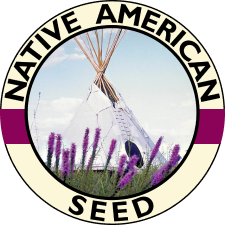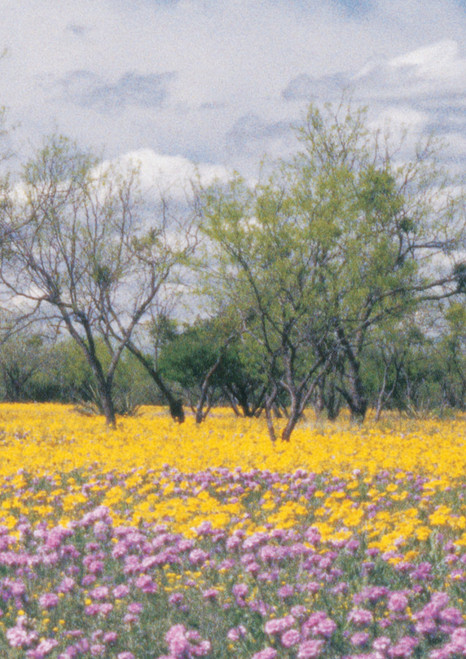Horned Lizards are a pocket-sized piece of the vanishing prairie. As the State Reptile of Texas and the first animal ambassador of the West sent from Lewis & Clark, “Horny Toads” are an approachable, living symbol of wild America on the Great Plains. The Texas or Plains Horned Lizard depends on a diverse assortment of seed-producing native wildflowers and bunchgrasses that sustain the social insects like Seed Harvester Ants that they eat. Bare ground micro-trails between the bunches of prairie grasses and forbs allow the lizards to camouflage against the soil, bask, and forage for prey. Native American Seed is proud to develop the first commercially available native seed mix to help people restore the habitat and food web of this beloved and charismatic reptile.
Feature on CBS Texas' Climate Connection
Horned Lizard Habitat Mix takes the doctrine of native plants to heart and applies it to something new. Horned Lizard Habitat Mix is groundbreaking because, to our knowledge, it is the first commercially available native plant seed mix for a reptile. All species of land animals depend ultimately on the native plants that support their food web. That's because (1) All energy comes from the sun (2) Plants capture that energy and convert it to food for themselves (3) Plants develop defenses over geologic time to protect themselves from others taking that food energy (4) Insects and other animals have to eat anyway so they develop counter-adaptations over geologic time to get around plants' defenses and borrow that food energy from the plants, and (5) the plants that have been around long enough for insects to adapt specializations for getting past the plants' defenses (for food) happen to be the native plants. While Native American Seed has helped pioneer the way for creating native plant seed mixes for wildlife species that can fairly easily cross roadways on the wing to get to a native plant they need—species like birds, bees, and butterflies—we have recognized the need to "bring nature home" to the other beloved creatures that need a little more help.
Millions of Americans remember playing with "Horny Toads" in bygone decades. That's because Horned Lizards are one of the last pieces of the prairie that held on. As the prairie was first de-buffaloed, de-prairie dogged, de-wolfed, and eventually de-grassed of its natives, only the smaller species that could hang on to the scantiest patches of degraded prairie remained. Horny Toads and the Prairie Seed Harvester Ants they ate were among these, but they too eventually succumbed—first in the tallgrass prairie of the Southern Great Plains—but eventually too in the midgrass prairie as their populations have contiuously receded westward. This alarmed many a plainsfolk, and in 1967 the Texas Horned Lizard was designated a threatened species by the Texas Parks and Wildlife Department. The State of Oklahoma also followed suit, granting Horny Toads some protection. In 1993, the Texas House and Senate adopted a resolution to officially designate the Texas Horned Lizard as the State Reptile of Texas. And while such designations and resolutions help state governments heed the plight of horny toads, these were only the beginning course of action.
What can be done to help Horny Toads? The first step is restoring the native plants and natural processes that made the Horned Lizard's prairie-home. And because so much land in the Southern Great Plains is privately owned and managed, it's going to take everyone's help. And that's the exciting part. YOU get to help bring the Horned Lizard back to its native home by planting the seeds it needs to restore its habitat and food web! Plant Horned Lizard Habitat Mix on ranches, ranges, alleyways, turnrows, schoolyards, church yards, frontyards, and backyards. Every little corner of restored habitat can one day welcome a grateful Horned Lizard and make him happy. It takes a while to restore something that was lost—so we might as well roll up our sleeves and make ready the Horny Toad's homecoming.
Horned Lizards need a mosaic of grassland habitat types. Horny Toads need some shortgrass areas with some bare soil inbetween plants to bask and forage in the sun. (Restoring prairie dogs, prescribed burns, and rotationally grazing bovines with long rest periods for the bunchgrasses can help here!) They also need some ungrazed, unburned, unmowed tallgrasses or native "weedy" areas nearby to escape midday heat and hide from hungry predators. Even a tree or mott about as far as a softball throw away, but generally no denser, is an additional welcome shade structure in a Horny Toad's grassland.
Check out this video from Texas Wildlife Association and Dr. Dale Rollins to understand the link between the habitat needs of Horned Lizards and that of other prairie species—like Bobwhite Quail—that have also disappeared or dwindled in number in recent decades:
Ranch management for Horned Lizard restoration:
If you are wanting to restore, improve, or connect Horned Lizard habitat on your ranch and need in-depth consulting and rangeland management planning for the state reptile of Texas, contact our team member and horned lizard biologist Dusty (dusty@seedsource.com) to discuss possibilities.
- AMERICAN BASKETFLOWER
- BIG BLUESTEM
- COMMON SUNFLOWER
- WOOLLY CROTON
- EASTERN GAMAGRASS
- ILLINOIS BUNDLEFLOWER
- INDIANGRASS
- LITTLE BLUESTEM
- MAXIMILIAN SUNFLOWER
- PARTRIDGE PEA
- PLAINS BRISTLEGRASS
- PURPLE PRAIRIE CLOVER
- SCRAMBLED EGGS
- SIDEOATS GRAMA
- SLIM TRIDENS
- SOUTHWESTERN BRISTLEGRASS
- SWITCHGRASS
- BLUEBONNET
- TEXAS CUPGRASS
- TEXAS YELLOW STAR
- WHITE PRICKLY POPPY
- ARIZONA COTTONTOP
- BLUE GRAMA
- BUFFALOGRASS
- BUSH SUNFLOWER
- CURLY MESQUITE
- GREEN SPRANGLETOP
- GREENTHREAD
- HOODED WINDMILL GRASS
- HUISACHE DAISY
- MEALY BLUE SAGE
- PLAINS COREOPSIS
- PURPLE CONEFLOWER
- PRAIRIE WILDRYE
- PURPLE THREE AWN
- RED LOVEGRASS
- SAND DROPSEED
- SAND LOVEGRASS
- SLENDER GRAMA
- TALL DROPSEED
- TEXAS GRAMA
- TEXAS WINTERGRASS
- VIRGINIA WILDRYE
- WESTERN WHEATGRASS
- WHITE TRIDENS
- INDIAN BLANKET
- WHITE PRAIRIE CLOVER
- STANDING CYPRESS
- LANCELEAF COREOPSIS
- CUTLEAF DAISY
- LEMON MINT
- GOLDEN-WAVE
- WINECUP (ANNUAL)
- COWPEN DAISY
- GAYFEATHER BLAZING STAR
- BLACK-EYED SUSAN
- PRAIRIE VERBENA
- BUTTERFLY WEED
- CLASPING CONEFLOWER
- TAHOKA DAISY
- PRAIRIE CONEFLOWER
- SWAMP MILKWEED
- SHOWY MILKWEED
- BLUE WILD INDIGO
- SMOOTH WHITE PENSTEMON
- MEXICAN HAT
- GAYFEATHER
- WHITE ROSINWEED
- STIFF GOLDENROD
- PRAIRIE GOLDENROD
- DRUMMOND PHLOX
- LITTLE BLUESTEM PINEYWOODS
- LITTLE BLUESTEM CENTRAL TEXAS
- WACO INDIANGRASS
- CANE BLUESTEM
- TALL GRAMA
- PURPLE LOVEGRASS























